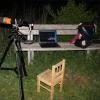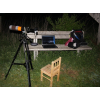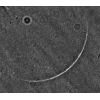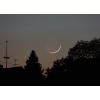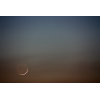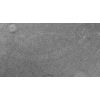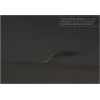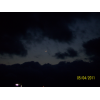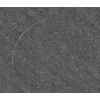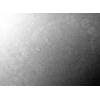Visibility of Jumadal Al-Aakherah Crescent 1432 AH
- When to Observe Jumadal Al-Aakherah Waxing (NEW) Crescent ?
- Jumadal Al-Aakherah Waxing (NEW) Crescent Observation Results
- The OFFICIAL First Day in Different Countries
- When to Observe Jumadal Al-Aula Waning (OLD) Crescent ?
- Jumadal Al-Aula Waning (OLD) Crescent Observation Results
When to Observe Jumadal Al-Aakherah Waxing (NEW) Crescent ?
The geocentric conjunction (Geocentric New Moon) will occur Inshalla on (Tuesday 03 May 2011) at 06:51 UT.
Sighting the new crescent on (Tuesday 03 May 2011) and (Wednesday 04 May 2011) is shown in the below graphs using the program Accurate Times by Mohammad Odeh according to Odeh criterion. Where:-
- It is impossible to see the crescent from the areas located under the red color. Because either the Moon on this day sets before the Sunset and/or the topocentric conjunction occurs after the Sunset.
- The crescent is expected to be seen by optical aid only from the areas located under the blue color.
- The crescent is expected to be seen by optical aid from the areas located under the magenta color. In these areas the crescent could be seen by naked eye if the atmospheric conditions are superb and the observer is experienced.
- The crescent is expected to be easily visible by naked eye from the areas located under the green color.
- The crescent cannot be seen from uncolored areas, even though the Moon sets in these locations after the Sunset and the topocentric conjunction occurs before the Sunset, but the Moon is not sufficiently illuminated in order to be seen as crescent even by optical aid.
- Kindly notice that the below graph shows the possibility of seeing the crescent from areas between 60 degrees north of Equator down to 60 degrees south of Equator.
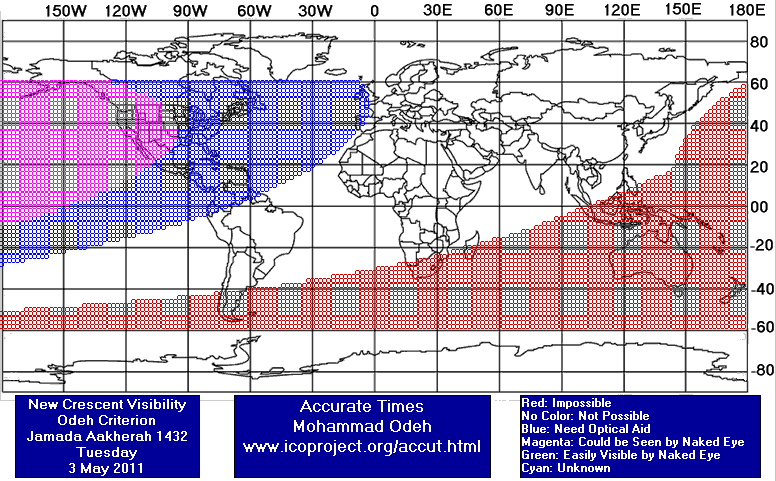
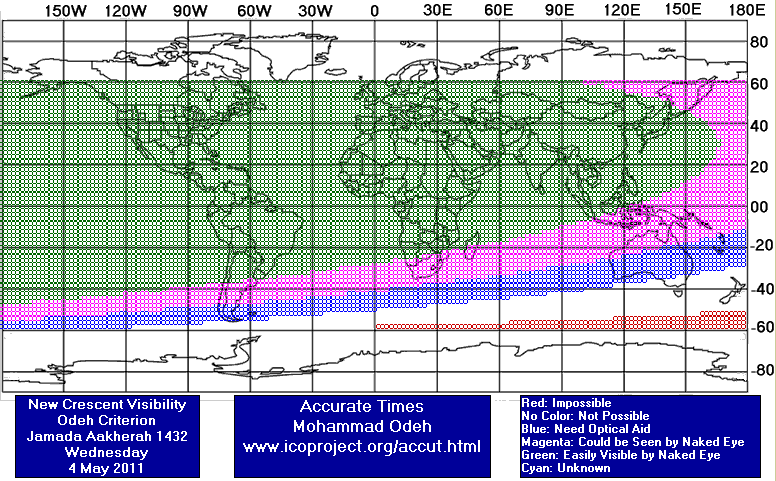
According to the Universal Hejric Calendar (UHC), which is based on the calculated crescent visibility, the start of this month in the Eastern Region will be on Wednesday 04 May 2011 and in the Western Region will be on Wednesday 04 May 2011. Kindly notice that the UHC is a pre-calculated calendar, which adopts a certain criterion to start the new Hejric month. Your country/organization might adopt different criterion to start the new Hejric month. So it is highly advised to read the UHC website before giving any judgment.
- Results of seeing the crescent, and the first day of the month in different countries will be added here Inshalla as we receive the reports from ICOP's members. If you wish to be a member in ICOP, or to know more about it, kindly click here.
Jumadal Al-Aakherah Waxing (NEW) Crescent Observation Results
Tue 03 May 2011
Algeria
Mr. Hocine Chikh Aissa said: "(12) persons were present in N'tissa station and have tried to observe the Jumada II 1432 crescent but it wasn't seen. The western horizon was supreb after rain. They have used one binocular : 50x7"
Germany
Eng. Martin Elsaesser said: "I gave it a try with the imaging equipment from a local site, but could only carry a small lens with tripod. Weather conditions were very hazy near the horizon (at only 5°C, clouds from day-long rain just moving away) and i was not sure enough of the position. I tried scanning back and forth across the assumed path of the crescent for 30 minutes but could NOT see the crescent on the screen, nor find it in the saved images later. At only 5.5° of elongation it takes better weather and better preparation."
United Kingdom
Eng. Qamar Uddin said: "On Tuesday 3 May 2011 (29 Jumada Al-Ula 1432 AH) many people from throughout UK have attempted to sight the crescent moon (Hilal) of Jumada Al-Ukhra (or Jumada Al-Thani) after sunset. None of the groups were able to sight the Hilal, even though some places had clear sky conditions. We have not received any reliable sighting news from countries east of UK or Morocco either. Fax received from Morocco Awqaf Ministry had negative sighting reports from all 278 points within the entire country. Therefore, the Ulama (including Wifaq/Batley) have decided that the month of Jumada Al-Ula 1432 AH will complete 30 days and the month of Jumada Al-Ukhra 1432 AH will start from Thursday 5 May 2011, Insha-Allah."
United States
Dr. Javad Torabinejad said: "This evening (Tuesday, May 03, 2011), the sky was totally cloudy in Blacksburg, VA, and thus there was no chance of sighting the crescent."
Dr. John Caldwell said: "43 min lag, some cloud bands but "clear" bands too, surprised not to see it in binoculars, did not look like so bad conditions, even saw multiple very distant airplane trails near that horizon"
Mr. Jim Stamm said: "Observed: Tuesday; May 03, 2011 - 19:18 (Local). Location (WGS 84) = Tucson, Arizona (USA). Longitude = 110.9651 W. Latitude = 32.4206 N. Elevation = 842 meters. Time Zone = -7.0 hours. Surface conditions at location: Temperature = 26 °C. Humidity = 5 %. Pressure = 29.85 in.A few clouds near the horizon, but none interfering. Topocentric and local time values from “Accurate Times”: Sunset (at sea level) = 19:11. Moonset (at sea level) = 19:57. Time from new moon at 19:32 = 19 hr. 13 min. Moon lag time = 46 min. Relative Altitude = 8.7 degrees. Elongation from sun = 8.7 degrees. Crescent width = 10 arc seconds. Illumination = 0.6 percent. Crescent first observed through 8” SC telescope: Time = 19:18. Moon Altitude = 4.1 degrees. Final observation with telescope: Time = 19:38. Moon Altitude = 1.7 degrees. I pre-aimed the scope the night before. The crescent was invisible in the eyepiece FOV from 19:14 until 19:18, when it became visible right in the center of the FOV. The length of the crescent was about 30 degrees initially. It grew southward to 60 degrees by 19:20, southward to 80 degrees by 19:23, southward to 90 degrees by 19:24, and slowly northward to 100 degrees by 19:28. For the next ten minutes the length of the arc of the crescent did not seem to grow at all. I lost the moon in the trees at 19:38. I tried to view the crescent with two different binoculars and my finder, without success. I also tried to photograph the crescent by holding a camera at the eyepiece, without success. "
Wed 04 May 2011
Bangladesh
Germany
Eng. Martin Elsaesser said: "The crescent could easily be seen with the naked eye after sunset. It also passed the well known open cluster of the seven sisters (Pleades) which gave a nice view during twilight. Earlier in the day, it was also observed with the video technique during the day. "
Ghana
Mr. Abdul-Aziz Anyang said: "Since today May 04, 2011 is the 30th day for Jumada Ula 1432 AH and as the new crescent is expected to be seen today. tomorrow Thursday May 05, 2011 is the first day for Jumada Thaani, 1432."
Nigeria
Mr. Abdul-Rasaq Abdul-Azeez Ishola said: "We tried to search the Jumadah Thanni crescent today 4-5-11 in Jubilee Estate and my Collegue Sheik Majolage in Ita elewa Ikorodu but the moon was not seen due to total cloudness, and I call Prof. Nafaty in Bauchi and Brother Simwal in Kaduna and Brother Bari Kerim all claimed Nagative due to cloudness but when I call Prof. gwandu In Sokoto he said the moon was sighted by himself and other brothers at the sea side in Sokoto today. "
Saudi Arabia
South Africa
United Arab Emirates
Eng. Mohammad Odeh said: "Hidden haze! Yes hidden haze! It was really difficult to imagine how hazy the sky was until the Sun had set, where I was not able to see the crescent by telescope despite the fact that it had to be easily seen by naked eye! The accuracy of the telescope was tested several times by pointing it to Venus and Sirius and they were seen in the field of view! Also, the Sun itself had disappeared well before the actual sunset time! 22 trials were done by CCD imaging to see the crescent from 10 am till 06 pm. The crescent was barely visible in the 13th trial at 16:35 (LT). The elongation at that time was 13.5 degrees, Moon altitude was 43 degrees, and the Sun altitude was 30 degrees. The crescent was also visible in the 14th trial at 17:00 LT but it was more difficult to be seen than the 13th trial! The last trial in which the crescent was visible was the 15th trial at 17:09! In that trial the crescent was VERY difficult to be seen! All these trials show how critical the haze is on crescent observation! So always do you best to observe from the highest possible altitude to reduce the haze effect! Below are two photos for the crescent for the 13th trial. Kindly notice that it is the same photo with different processing settings."
United Kingdom
Eng. Qamar Uddin said: "On Wednesday 4 May 2011 (30 Jumada Al-Ula 1432 AH) a few of us tried to sight the crescent moon (Hilal) of Jumada Al-Ukhra after sunset. The western sky was partly cloudy, but we managed to sight the Hilal with 10x50 binoculars at 21:09 hrs BST and by naked eye at 21:14 hrs BST (see attached photo). The Hilal was also live broadcasted on the Internet and partly recorded online (2 mins). Note that the Ulama in UK have already decided yesterday to start Jumada Al-Ukhra 1432 from Thursday 5 May 2011 by completing Jumada Al-Ula as 30-days."
United States
Dr. Javad Torabinejad said: "This evening (Wednesday, May 04, 2011), the crescent moon was sighted in Blacksburg, VA (Lat: 37° 15' 40" N, Lng: 80° 26' 56" W, and elevation: 646 meter). Driving to my sighting location, I sighted the moon at 8:47 pm in a small clearing in a mostly cloudy western horizon (sunset: 8:13 pm EDT). After arriving at the location, I could see the moon for a longer time. The horns were at 3:00 and 7:00 O'clock (3:00;5:00;7:00). I stayed there till 9:03 pm (moonset: 9:53 pm EDT)."
The OFFICIAL First Day in Different Countries
Wed 04 May 2011
1 . Bahrain
2 . Egypt
3 . Jordan
4 . Kuwait
5 . Palestine
6 . Qatar
7 . Saudi Arabia
8 . Syria
9 . United Arab Emirates
Thu 05 May 2011
1 . Ghana
2 . Indonesia
3 . Morocco
4 . Nigeria
5 . Oman
6 . United Kingdom
Fri 06 May 2011
1 . Bangladesh
2 . South Africa
When to Observe Jumadal Al-Aula Waning (OLD) Crescent ?
The geocentric conjunction (Geocentric New Moon) will occur Inshalla on (Tuesday 03 May 2011) at 06:51 UT.
Sighting the OLD crescent on (Tuesday 03 May 2011) and on (Monday 02 May 2011) is shown in the below graphs using the program Accurate Times by Mohammad Odeh according to Odeh criterion. Where:-
- It is impossible to see the OLD crescent from the areas located under the red color. Because either the Moon on this day rises after the Sunrise and/or the topocentric conjunction occurs before the Sunrise.
- The crescent is expected to be seen by optical aid only from the areas located under the blue color.
- The crescent is expected to be seen by optical aid from the areas located under the magenta color.. In these areas the crescent could be seen by naked eye if the atmospheric conditions are superb and the observer is experienced.
- The crescent is expected to be easily visible by naked eye from the areas located under the green color.
- The crescent cannot be seen from uncolored areas, even though the Moon rises in these locations before the Sunrise and the topocentric conjunction occurs after the Sunrise, but the Moon is not sufficiently illuminated in order to be seen as crescent even by optical aid.
- Kindly notice that the below graph shows the possibility of seeing the crescent from areas between 60 degrees north of Equator down to 60 degrees south of Equator.
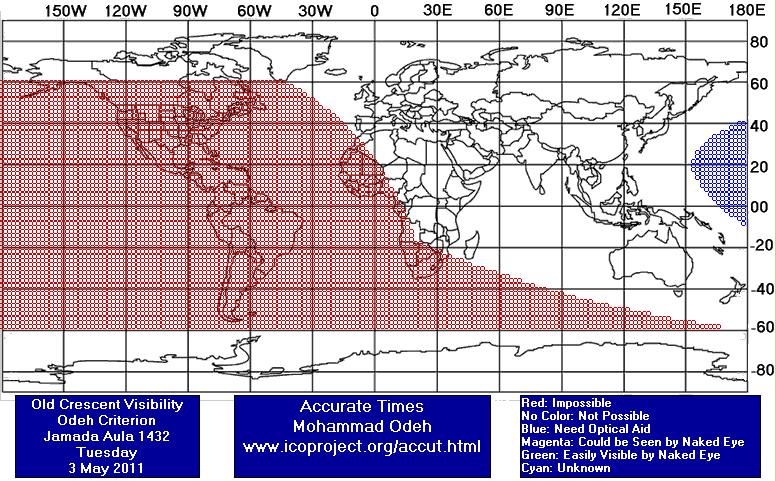
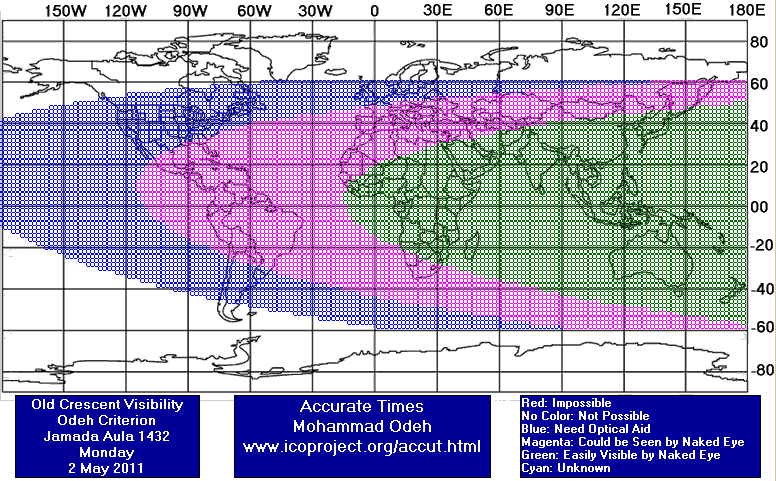
Jumadal Al-Aula Waning (OLD) Crescent Observation Results
Sun 01 May 2011
Germany
Eng. Martin Elsaesser said: "The crescent was easily seen with the naked eye and small binoculars, after it had risen above some low cloud layer."
United Kingdom
Eng. Qamar Uddin said: "The eastern horizon before sunrise was totally cloudy, hence the waning crescent was not seen from York (UK)."
Mon 02 May 2011
Germany
Eng. Martin Elsaesser said: "I tried to observe the crescent during morning twilight, but did not succeed due to lots of fog, that went higher than my observation spot, a local sight-seeing tower. The upper-most layer of fog was flowing over me, but that was not good enough to see the thin crescent. The fog/clouds only resolved after noon, but a lot of haze remained and conditions weree quite bad. I could not see the crescent visually in a small telescope, so i had to resort to the imaging approach. Despite a very low contrast of less than 1% brightness increase vs. the surrounding sky and any amount of haze and flying insects and pollen and such, the crescent could be imaged and viewed on the live-screen at about 9.6° elongation from the sun. At the time of observation the old crescent was already descending again in front of the sun."
United Arab Emirates
Eng. Mohammad Odeh said: "Seen by CCD imaging at: 10:26 LT (UT+4). Weather Conditions were not perfect. I'd consider it to be a little bit below the average for this area. Generally speaking, it was well below the good atmospheric conditions!"
United States
Mr. Jim Stamm said: "Old Moon Crescent Observation Report ====================================== Observed: Monday; May 02, 2011 - 05:34 (Local) Location (WGS 84) = Tucson, Arizona (USA) Longitude = 110.9651 W Latitude = 32.4206 N Elevation = 842 meters Time Zone = -7.0 hours Surface conditions at location: Temperature = 11 °C Humidity = 11 % Pressure = 30.10 in. No noticeable haze before twilight. Very slight haze at my moonrise (5° altitude). Magnitude limit at 3 degrees altitude with 55 power in C-8 telescope, before onset of twilight = 11.0 Topocentric and local time values from “Accurate Times”: Moonrise (at sea level) = 04:54 Sunrise (at sea level) = 05:32 Time from new moon at 05:15 = 19 hr. 01 min. Moon lag time = 38 min. Relative Altitude = 7.4 degrees Elongation from sun = 8.7 degrees Crescent width = 10 arc seconds Illumination = 0.6 percent I was NOT able to see the crescent, even through a telescope, with definite aim and focus. Observer: Jim Stamm E-mail Address: StammJim@gmail.com"


